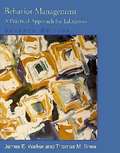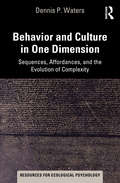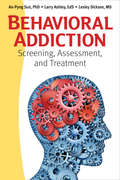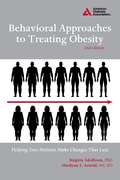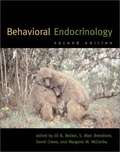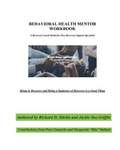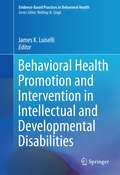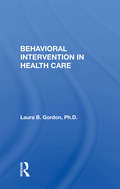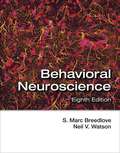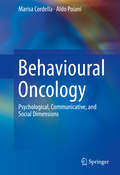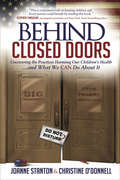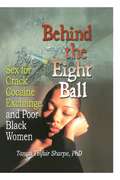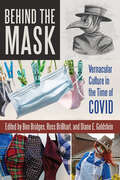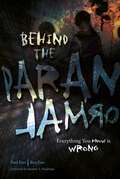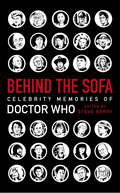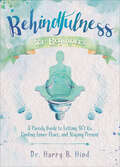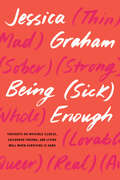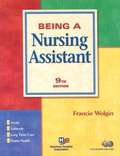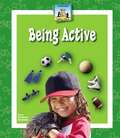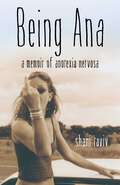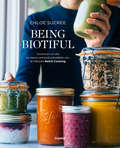- Table View
- List View
Behavior Management: A Practical Approach for Educators
by James E. Walker Thomas M. SheaChild psychology textbook aimed at teachers.
Behavior and Culture in One Dimension: Sequences, Affordances, and the Evolution of Complexity (Resources for Ecological Psychology Series)
by Dennis P. WatersBehavior and Culture in One Dimension adopts a broad interdisciplinary approach, presenting a unified theory of sequences and their functions and an overview of how they underpin the evolution of complexity. Sequences of DNA guide the functioning of the living world, sequences of speech and writing choreograph the intricacies of human culture, and sequences of code oversee the operation of our literate technological civilization. These linear patterns function under their own rules, which have never been fully explored. It is time for them to get their due. This book explores the one-dimensional sequences that orchestrate the structure and behavior of our three-dimensional habitat. Using Gibsonian concepts of perception, action, and affordances, as well as the works of Howard Pattee, the book examines the role of sequences in the human behavioral and cultural world of speech, writing, and mathematics. The book offers a Darwinian framework for understanding human cultural evolution and locates the two major informational transitions in the origins of life and civilization. It will be of interest to students and researchers in ecological psychology, linguistics, cognitive science, and the social and biological sciences.
Behavior and Culture in One Dimension: Sequences, Affordances, and the Evolution of Complexity (Resources for Ecological Psychology Series)
by Dennis WatersBehavior and Culture in One Dimension adopts a broad interdisciplinary approach, presenting a unified theory of sequences and their functions and an overview of how they underpin the evolution of complexity.Sequences of DNA guide the functioning of the living world, sequences of speech and writing choreograph the intricacies of human culture, and sequences of code oversee the operation of our literate technological civilization. These linear patterns function under their own rules, which have never been fully explored. It is time for them to get their due. This book explores the one-dimensional sequences that orchestrate the structure and behavior of our three-dimensional habitat. Using Gibsonian concepts of perception, action, and affordances, as well as the works of Howard Pattee, the book examines the role of sequences in the human behavioral and cultural world of speech, writing, and mathematics. The book offers a Darwinian framework for understanding human cultural evolution and locates the two major informational transitions in the origins of life and civilization. It will be of interest to students and researchers in ecological psychology, linguistics, cognitive science, and the social and biological sciences.
Behavioral Addiction
by Larry Ashley Lesley Dickson An-Pyng SunWritten in scientific prose that can also be understood by the layperson, this comprehensive volume is a must-read for those working in the addiction field and anyone interested in learning more about this devastating disease.An-Pyng Sun, PhD, is a professor at the University of Nevada, Las Vegas School of Social Work.Larry Ashley, EdS, LCADC, is the addictions specialist and undergraduate coordinator at the University of Nevada, Las Vegas.Lesley Dickson, MD, is ABPN board-certified in general psychiatry, addiction psychiatry, and psychosomatic illness.
Behavioral Approaches to Treating Obesity
by Marilynn S. Arnold Birgitta AdolfssonAs governments and health care systems direct more attention and resources to treating the rising rates of obesity worldwide, one thing has become very clear: obesity is best treated as a chronic condition. The most effective approach to care is often a behavioral one, in which health care providers and patients rely on teamwork, respect, and conversation to motivate lifestyle change. This collaborative model is essential because decisions about care ultimately rest with the patient. Working together, care providers and patients can help patients learn to make healthy choices throughout their lives.An effective and detailed guide for health care providers, Behavioral Approaches to Treating Obesity embraces this understanding about treating obesity and explains how to help patients direct their own lifestyle change. With this self-directed approach to clinical care, patients assume more responsibility for their treatment plans, whereas care providers learn to take on the role of guide or counselor.In this book, readers will find strategies for encouraging patients and equipping them for lifestyle change. There is practical advice on many issues and helpful guides for any of a number of difficult scenarios. Some of the features of this guide include:arranging the physical environment of a clinic to accommodate obese patientsbuilding a program to meet the needs of patients in a chronic-care treatment plancase studies to illuminate key issues in behavior changecharts and tables to help implement behavioral approaches in treatmentstep-by-step instructions on helping patients begin lifestyle changedescriptions of how to design and organize an obesity treatment programuseful methods of building a collaborative health care teamReaders will start at the beginning, learning to understand the problems of obesity and risks it poses to the people who suffer from the condition. Then the methods of treatment for obesity are presented, along with analysis of these methods and their effectiveness. In the end, the authors conclude that a new paradigm of care is needed to successfully treat obesity.The next section spends some time redefining the roles of health care providers in providing a collaborative care model of behavioral change therapy. The authors describe the new roles for health care providers and how to cope with those changes, how to build their team, how to create a supportive environment, and then how to structure the care process.The third and final section provides health care providers with the tools they need to introduce behavioral self-care in the clinical environment. This is a step-by-step process, and each step is further explained using case studies from the authors' experiences.The book is completed with an extensive resources section and an updated reference list to promote further research.
Behavioral Emergencies for the Emergency Physician
by Mary Nan S. Mallory Lara G. Chepenik Leslie S. ZunEmergency physicians, in all practice settings, care for patients with both undifferentiated psycho-behavioral presentations and established psychiatric illness. This reference-based text goes beyond diagnostics, providing practical input from physicians experienced with adult emergency psychiatric patients. Physicians will increase their understanding and gain confidence working with these patients, even when specialized psychiatric back-up is lacking. Behavioral Emergencies for the Emergency Physician is comprehensive, covering the pre-hospital setting and advising on evidence-based practice; from collaborating with psychiatric colleagues to establishing a psychiatric service in your ED. Sedation, restraint and seclusion are outlined. Potential dilemmas when treating pregnant, geriatric or homeless patients with mental illness are discussed in detail, along with the more challenging behavioral diagnoses such as malingering, factitious and personality disorders. This go-to, comprehensive volume is invaluable for trainee and experienced emergency physicians, as well as psychiatrists, psychologists, psychiatric and emergency department nurses and other mental health workers.
Behavioral Endocrinology (2nd edition)
by Jill B. Becker S. Marc Breedlove David Crews Margaret M. MccarthyThis popular behavioral endocrinology text provides detailed information on what hormones are, how they affect cells, and how such effects can alter the behavior of animals, including humans. Presenting a broad continuum of levels of analysis, from molecular to evolutionary, the book discusses how genes work, the structure of cells, the interactions of endocrine organs, the behavior of individuals, the structure of social hierarchies, and the evolution of mating systems. The second edition, while maintaining the strengths of the first edition, has been thoroughly revised to reflect recent developments in genetics and molecular biology and related social concerns. It contains four new chapters: on the use of molecular biology techniques in behavioral endocrinology, on psychoneuroimmunology, on hormonal influences on sensorimotor function, and on cognitive function in nonhuman animals.
Behavioral Health Mentor Training: A Recovery Coach Model for Peer Recovery Support Specialist
by Richard D Davila; Jackie Sue Griffin; Peter Gamache; Marguerite BallardThis workbook is a look at a way for persons who want to be Peer Recovery Support Specialist (PRSS) and helpers working with persons with co-ocurring disorders (addiction/mental health issues). We include such topics as self care, what a a PRSS is and is not, how to develop a wellness plan, multiple family awareness (co-dependency, enabling, traits of a healthy family), etc.
Behavioral Health Promotion and Intervention in Intellectual and Developmental Disabilities (Evidence-Based Practices in Behavioral Health)
by James K. LuiselliThis book discusses the latest evidence-based practices andhow they can be implemented to address health problems in people withintellectual and developmental disabilities (IDD). It offers variousintervention and prevention strategies for treating commonly encountered issuesin patients with IDD, such as eating and sleeping disorders, repetitiveself-harming behaviors, and personal hygiene problems. Primary strategiesinclude encouraging healthful habits, reducing noncompliance and risk-takingbehaviors, and direct intervention to promote optimum functioning while reducingdiscomfort, frustration, and adverse behaviors. In addition, contributors describetraining and consultation models to enable readers to work more effectivelywith practitioners, clinicians, and parents as well as with the patientsthemselves. Topics featured in this book include: Compliance with medical routines. Increasing and maintaining exercise and other physical activities. Assistive technologies in severe and multiple disabilities. Substance use and health-related issues. Consultation with medical and healthcare providers. Parent training and support. Behavioral HealthPromotion and Intervention in Intellectual and Developmental Disabilities isa valuable resource for researchers, clinicians, and graduate students inclinical psychology, behavioral therapy/rehabilitation, social work, publichealth, and other interrelated fields.
Behavioral Intervention In Health Care
by Laura B. GordonIn this book, the author presents a behavioral-psychological perspective on intervention in health care, beginning with a definition of behavioral medicine and introducing the related issues of stress and patient compliance.
Behavioral Neurology & Neuropsychiatry
by Christopher M. Filley David B. Arciniegas C. Alan Anderson T. Angelita GarciaThe merger of behavioral neurology and neuropsychiatry into a single medical subspecialty, Behavioral Neurology & Neuropsychiatry, requires an understanding of brain-behavior relationships and a clinical approach that transcends the traditional perspectives of neurology and psychiatry. Designed as a primer of concepts and principles, and authored by a multidisciplinary group of internationally known clinical neuroscientists, this book divides into three sections: * Structural and Functional Neuroanatomy (Section I) addresses the neuroanatomy and phenomenology of cognition, emotion, and behavior * Clinical Assessment (Section II) describes neuropsychiatric history taking, neurological and mental status examinations, neuropsychological assessment, and neuroimaging, electrophysiologic, and laboratory methods * Treatment (Section III) discusses environmental, behavioral, rehabilitative, psychological, social, pharmacological, and procedural interventions for cognitive, emotional, and behavioral disorders. By emphasizing the principles of Behavioral Neurology & Neuropsychiatry, this book will improve your understanding of brain-behavior relationships and inform your care of patients and families affected by neurobehavioral disorders. David B. Arciniegas, MD is the Michael K. Cooper Professor of Neurocognitive Disease, Director of the Neurobehavioral Disorders Program, and Associate Professor of Psychiatry and Neurology at the University of Colorado School of Medicine. C. Alan Anderson, MD is Professor of Neurology, Emergency Medicine, and Psychiatry at the University of Colorado School of Medicine, and Staff Neurologist at the Denver Veterans Affairs Medical Center. Christopher M. Filley, MD is Professor of Neurology and Psychiatry, and Director of the Behavioral Neurology Section at the University of Colorado School of Medicine, and Neurology Service Chief at the Denver Veterans Affairs Medical Center.
Behavioral Neuroscience (Eighth Edition)
by S. Marc Breedlove Neil V. WatsonFor 20 years, instructors have relied on the textbook Biological Psychology for a definitive and comprehensive survey of the neuroscience of behavior. Thanks to the explosion of work in the neurosciences, each of the seven editions has included more neural details than the one before. Thus the time has come to revise the title to reflect the evolution of both the book and the field: Behavioral Neuroscience. <P> Behavioral Neuroscience, Eighth Edition, provides undergraduates with a lively survey of the field. It offers a broad perspective, encompassing cutting edge neuroscience, lucid descriptions of behavior, evolutionary and developmental perspectives, and clinical applications of research. Despite this comprehensive range of material, the authors have striven in the latest revision to lay bare the neuroscience concepts underlying behavior with concision and clarity.
Behavioural Oncology: Psychological, Communicative, and Social Dimensions
by Aldo Poiani Marisa CordellaMedical, educational, and public health efforts have reduced the spread of many major diseases, yet cancer perseveres, in spite of continuing research and improvements in practice. Especially promising among therapeutic strategies are ones that recognise patients as individuals with thoughts, feelings--and speech. Rooted in deep understanding of the mutual relationship between behavior and cancer, Behavioural Oncology combines extensive clinical wisdom and empirical data to illuminate the psychological, social, and existential aspects of cancer, and to offer a framework for empathic, patient-centered care. Chapters delve into the psychobiology of long-term illness, examining stress, pain, fatigue, sensory and sleep disturbances, and other quality of life issues as well as considerations of age, gender, culture, and comorbidity. The book's emphasis on linguistic and communicative aspects of cancer--and practical skills from respecting patient narratives to delivering bad news--adds necessary depth to concepts of the therapeutic relationship. In this way, the authors warn about overmedicalizing cases to the point of losing patient identity. Major areas of the coverage include: Biology and behavior in cancer prevention and suppression. The psychology of cancer patients: emotions, cognition, and personality Social dimensions, including stigma, coping, and social support Language, communication, and cross-cultural issues Existential, spiritual, and end-of-life concerns Doctor-patient relationships The psychological benefits of complementary therapies Bringing new scope and substance to familiar mind/body constructs, Behavioural Oncology is a definitive reference for a spectrum of healthcare professionals, among them health and clinical psychologists, oncologists and family physicians, oncology nurses, and clinical social workers. Its discussion questions and summaries make it a suitable text for undergraduate and graduate courses in related topics.
Behind Closed Doors: Uncovering the Practices Harming Our Children's Health . . . and What We Can Do About It
by Joanne Stanton Christine O’DonnellBehind Closed Doors tells the story of two mothers who began investigating serious health issues in their own son and daughter—and ended up writing an expose about the declining health of an entire generation of American children. In their relentless attempts to improve the health of their own children, they uncovered harmful trends in our food, pharmaceuticals, and environment, all stemming from weak laws and conflicts of interest. What they discovered shocked and ultimately empowered them to get actively involved in questioning and reforming these harmful, out-of-balance practices, and to inspire other moms to do the same. Behind Closed Doors not only offers scientifically verified evidence of how declining industry practices are harming our kids, but showcases solutions like environmental medicine and other integrative health practices, shares personal success stories, and provides tools and solutions parents can immediately implement—equipping and inspiring us all to stand together for change.
Behind The Crystal Ball: Magic, Science, And The Occult From Antiquity Through The New Age
by Anthony AveniIn this fascinating exploration of occult practice, Anthony Aveni takes the reader on a whirlwind tour through time and space to unveil the many ways people have used magic over the millennia in hopes of improving their lives. As Aveni persuasively argues, the ancients sought what we now search for through science and religion - a clearer picture of humanity's place in the cosmos.
Behind the Eight Ball: Sex for Crack Cocaine Exchange and Poor Black Women
by Tanya Telfair SharpeInner-city black women open their hearts to share the pain of crack addiction and its consequences Behind the Eight Ball: Sex for Crack Cocaine Exchange and Poor Black Women documents an American tragedy that highlights the widening gap between social and economic classes. In their own words, poor black women-nameless, faceless, and marginalized by poverty-share the details of their lives before and after crack cocaine invaded their communities, each recalling the circumstances of her introduction to the drug and her first experience using sex to support her addiction. These candid interviews expose the socioeconomic changes in inner-city neighborhoods that created the perfect conditions for a crack stronghold; the crack cocaine economy's impact on the lives of inner-city residents; and the social and familial consequences of crack addiction among poor, black women. Behind the Eight Ball: Sex for Crack Cocaine Exchange and Poor Black Women places crack addiction, crack-related prostitution and its consequences, STDs, HIV, and pregnancy into the context of the larger social issues of inner-city poverty, race, gender, and class. This unique book reveals the sex-for-crack barter system as evidence of a long-term social exclusion and systemic racism that has worked to destroy the self-image of poor black American women. The women interviewed reflect this negative image, exchanging sex for crack on a regular basis to support their addictions at the risk-and reality-of unplanned pregnancies. "The baby I am carrying now, I don&’t know who the father is. There are a few (men) that I had sex with around the time I got pregnant-that day. But which one it is, I don&’t know who."Behind the Eight Ball: Sex for Crack Cocaine Exchange and Poor Black Women examines: why poor black women addicted to crack are disproportionately at risk for sexually transmitted diseases, including HIV, and unplanned pregnancies how the social and economic characteristics of poor black communities support crack distribution and consumption how crack use and the exchange of sex for crack damages struggling black families why the care of many children is entrusted to child welfare agencies how and why women are marginalized in the crack cultureBehind the Eight Ball: Sex for Crack Cocaine Exchange and Poor Black Women is an insightful and enlightening look at the motivations behind the decision to risk illness, injury, disease, death, and pregnancy to support addiction.
Behind the Mask: Vernacular Culture in the Time of COVID
by Diane E. Goldstein Ben Bridges Ross BrillhartVernacular responses have been crucial for communities seeking creative ways to cope with the coronavirus pandemic. With most people locked down and separated from the normal ebb and flow of life for an extended period of time, COVID-19 inspired community and creativity, adaptation and flexibility, traditional knowledge, resistance, and dynamism. Removing people from assumed norms and daily lives, the pandemic provided a moment of insight into the nature of vernacular culture as it was used, abused, celebrated, critiqued, and discarded. In Behind the Mask, contributors from the USA, the UK, and Scandinavia emphasize the choices that individual people and communities made during the COVID pandemic, prioritizing the everyday lives of people enduring this health crisis. Despite vernacular’s potential nod to dominant or external culture, it is the strong connection to the local that grounds the vernacular within the experiential context that it occupies. Exploring the nature and shape of vernacular responses to the ongoing public health crisis, Behind the Mask documents processes that are otherwise likely to be forgotten. Including different ethnographic presents, contributors capture moments during the pandemic rather than upon reflection, making the work important to students and scholars of folklore and ethnology, as well as general readers interested in the COVID pandemic.
Behind the Paranormal: Everything You Know Is Wrong
by Paul Eno Ben EnoJourney through the paranormal from prehistory to the planets and our future, with over 50 bizarre cases of ghosts, poltergeists, demons, cryptids, UFOs, and other out-of-the-ordinary phenomena. Based on CBS and WOON 1240 radio scripts broadcast by a world-famous father-and-son team of paranormal investigators, their research has revealed bizarre connections not only between seemingly unrelated occurrences but also between the paranormal and our everyday lives, the history of our species, and our possible future as a race. Meet inter-world parasites that might be farming your family or community, encounter disappearing buildings, and ghosts of people who aren’t dead. Push the boundaries as you find out what the Bible and other ancient documents might really mean, and what UFOs, invisible friends, and those footsteps in the attic could really be. Explaining the paranormal is not the problem. It’s handling the explanations. Everything you know is wrong.
Behind the Sofa: Celebrity Memories of Doctor Who
by VariousSteve Berry decided to do something a little bit different to raise funds for Alzheimer's Research UK. A life-long DOCTOR WHO fan, he began to interview celebrities, writers, actors and people who had worked on DOCTOR WHO, asking for their earliest memories of the show that sent us cowering behind the sofa. Now he presents the fruits of his four years of labour - a beautiful, touching book containing short articles and touching memories of one of the most successful TV shows ever. 2013 marks the 50th anniversary of DOCTOR WHO - this is the perfect way to enjoy those 50 years!This revised and expanded edition includes over 30 new entries from people such as Sophia Myles, Ben Aaronovitch, John Leeson and many moreContributors include comedians Al Murray, Stephen Merchant, and Bill Oddie; actors Lynda Bellingham, Nicholas Parsons, and Rhys Thomas; writers Neil Gaiman, Jenny Colgan, Jonathan Ross and Charlie Brooker and politicians Louise Mensch and Tom Harris. In addition, there is input from a number of the writers, actors and production staff who were involved in creating DOCTOR WHO stories new and old.
Behindfulness for Beginners: A Parody Guide to Letting Sh*t Go, Finding Inner Peace, and Staying Present (Illustrated Bathroom Bks.)
by Harry B. HindWhat happens when you bring mindfulness into the bathroom? A whole crapload of inspiring, cleansing, and healing behindfulness, that&’s what. Finally, holding onto your zen doesn&’t have to end when you shut the bathroom door. Behindfulness for Beginners hilariously presents the first-ever mindfulness journal specifically designed for those all-important, but often ignored, five-, ten-, eh maybe, fifteen-minute silent sitting sessions that we all do each and every day (serenity willing). So drop trou, take your seat, and prepare to enter a world of peace, relaxation, positive reflection, and fascinating facts about this sacred act: The Lost Art of Turtle Breathing: Learn the practice of cleansing kami breathing on the john; a technique named for turtles that can, for some reason, breathe through their butts. Look Inside: Reflect on just how much life you hold inside you—like the 100 trillion bacteria currently living in your digestive tract. Let That Sh*t Go, Literally: Interactively track just how much baggage you can shed each day (hint: the average person unburdens themselves of between 1 and 2 pounds daily).
Being (Sick) Enough: Thoughts on Invisible Illness, Childhood Trauma, and Living Well When Surviving Is Hard
by Jessica GrahamWise, visceral essays on navigating pain, sex, trauma, spirituality, addiction, recovery, and grief from queer, neurodivergent trauma-resolution guide Jessica GrahamIn an unapologetic look at living well with trauma and chronic illness, writer and meditation teacher Jessica Graham offers smart, funny, raw, and mindful insights on untangling—and embracing—the messy realities of being a human alive on this planet today.Graham gives us permission to accept care—and accept that it&’s okay to want care. They weave together personal stories and practical wisdom, offering their take on managing symptoms, getting creative, setting boundaries, and healing from ableist tropes like &“you don&’t look sick&” and &“we&’re all a little ADHD.&”Graham also shares vulnerable personal history: The adverse childhood experiences that wired their body and brain. The workaholism and addictions that kept their pain lying just below the surface. How illness and trauma intersect to obscure the knowledge that we&’re each enough, wholly as we are.This memoir explores the parts of chronic illness life that don&’t get enough airtime: How can we center sex and pleasure when pain gets in the way? How can we live well while living through late-stage capitalist hell? How can we come into relationship with our pain without falling prey to self-blame, magical thinking, or toxic positivity?Wise and embodied, fearless and necessary, Being (Sick) Enough is both a wild awakening and a love letter to your whole self: the pains and suffering, joys and brightness, and vital connections that hold each of us as we navigate what it means to be here, like this, right now.
Being A Nursing Assistant (9th Edition)
by Francie WolginThis book and all the accompanying supplements are designed to provide practical core material which makes up the foundation of nursing practice.
Being Active
by Mary Elizabeth SalzmannExplains in simple language the importance of regular physical activity.
Being Ana: A Memoir of Anorexia Nervosa
by Shani RavivShani Raviv is a misfit teen whose peer-pressured diet spirals down into full-blown anorexia nervosa—something no one in her early-nineties, local South African community knows anything about. Fourteen-year-old Shani spends the next six years being &“Ana&” (as many anorexics call it), on the run from her feelings. She goes from aerobics addict to Israeli soldier to rave bunny to wannabe reborn, using sex, drugs, exercise and, above all, starvation, to numb out everything along the way. But one night, at age twenty, Shani faces the rude awakening that if she doesn&’t slow down, break her denial, and seek help, she will starve to death. Three years later, her hardest journey of all begins: the journey to let go of being Ana and learn to love herself. Being Ana is an exploration into the soul and psyche of a young woman wrestling with anorexia&’s demons—one that not only exposes the real horrors of a day in the life of an anorexic girl but also reveals the courage it takes to stop fighting and find healing.
Being Biotiful: Comidas deliciosas, rápidas y saludables con el método Batch Cooking
by Chloé SucréeCuídate preparando comidas deliciosas, rápidas y muy saludables con el método Batch Cooking. ¡Organízate y disfruta! Comer saludable no siempre es fácil y más si volvemos tarde a casa, cansados y con mucha hambre y, al final, ya sea por falta de tiempo o de inspiración, es fácil caer en la trampa de comer algo precocinado, sin ningún tipo de elaboración y, por lo general, poco sano. Pero ¿y si te digo que se puede comer saludable aun teniendo poco tiempo? Chloé, fundadora del blog Being Biotiful que cuenta con miles de seguidores, nos enseña el método Batch Cooking, una manera de planificar y preparar comidas saludables, caseras y fáciles para toda la semana en tan solo una tarde. Tras años de práctica en el arte de tostar y mezclar semillas, batir frutas y verduras y combinar ingredientes de manera sorprendente, nos cuenta su historia y sus consejos esenciales e inspiradores para cambiar nuestra rutina alimentaria y encaminarnos hacia una dieta vegetariana, orgánica y de temporada.
